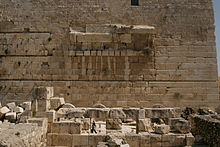
Back قوس روبنسون Arabic Robinson tağı Azerbaijani Arco de Robinson Spanish קשת רובינסון HE Robinson Kemeri Turkish 罗宾逊拱门 Chinese
קשת רובינסון | |
 Remains of Robinson's Arch above the Herodian street | |
| Location | Jerusalem |
|---|---|
| Coordinates | 31°46′33″N 35°14′05″E / 31.775739°N 35.234719°E |
| Part of | Herodian Temple Mount |
| Height | 21.25 metres (69.7 ft) |
| History | |
| Builder | Herod the Great |
| Material | local limestone |
| Founded | c. 20 BCE |
| Abandoned | 70 CE |
| Periods | early Roman Empire |
| Site notes | |
| Excavation dates | 1867–1870, 1968–1977, 1994–1996 |
| Archaeologists | Charles Warren, Benjamin Mazar, Ronny Reich, Yaacov Billig, Eli Shukron |
| Condition | ruin, archaeological park |
| Public access | yes |
Robinson's Arch is the name given to a monumental staircase carried by an unusually wide stone arch, which once stood at the southwestern corner of the Temple Mount. It was built as part of the expansion of the Second Temple initiated by Herod the Great at the end of the 1st century BCE. Recent findings suggest that it may not have been completed until at least 20 years after his death. The massive stone span was constructed along with the retaining walls of the Temple Mount. It carried traffic up from ancient Jerusalem's Lower Market area and over the Tyropoeon street to the Royal Stoa complex on the esplanade of the Mount. The overpass was destroyed during the First Jewish–Roman War, only a few decades after its completion.
The arch is named after Biblical scholar Edward Robinson who identified its remnants in 1838, though it was noticed earlier by Frederick Catherwood.[1] Robinson published his findings in his landmark work Biblical Researches in Palestine, in which he drew the connection with a bridge described in Josephus's Antiquities of the Jews and The Jewish War, concluding that its existence proves the antiquity of the Walls of Jerusalem.[2] Excavations during the second half of the 20th century revealed both its purpose and the extent of its associated structures. Today the considerable surviving portions of the ancient overpass complex may be viewed by the public within the Jerusalem Archaeological Park. As it is adjacent to Jerusalem's Western Wall worship area, a portion is used by some groups as a place of prayer.
- ^ Shimon Gibson (2021). "Archival notes on Robinson's Arch and the Temple Mount/Haram al-Sharif in Jerusalem". Palestine Exploration Quarterly. 153 (3): 222–243. doi:10.1080/00310328.2020.1805907.
- ^ Robinson, vol. 1, pp. 425–426
© MMXXIII Rich X Search. We shall prevail. All rights reserved. Rich X Search